12-在线制作
1. 需求分析
在创建代码生成器时,能够让用户在线使用生成器制作工具,通过输入制作信息、上传模板文件,就能直接得到制作好的生成器
2. 核心设计
1. 业务流程
- 用户打开在线制作工具表单,上传生成器信息和模板文件(制作工具依赖的参数)
- 后端下载模板文件到本地
- 构造生成器需要的元信息对象,并指定输出路径
- 后端调用 maker 制作工具,输入上述参数,得到代码生成器
- 后端将代码生成器返回给用户,前端下载
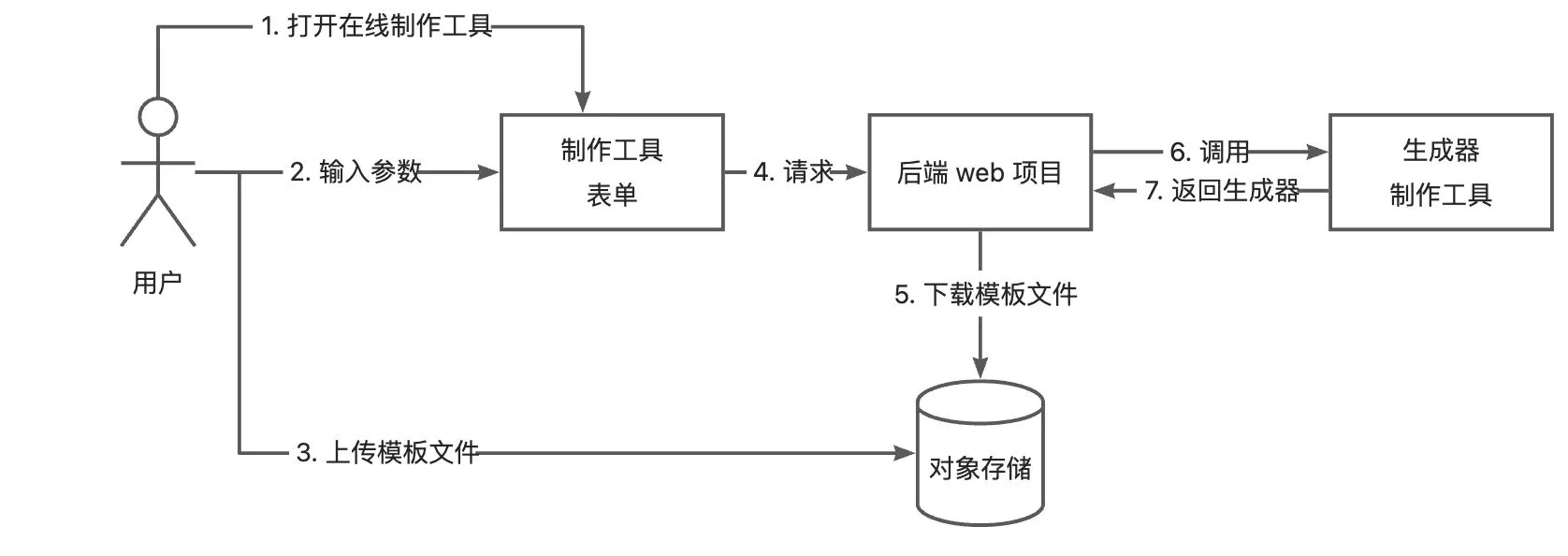
2. 问题分析
- 制作工具所需要的信息和文件从哪来?
- web 后端怎么调用 maker 制作工具项目来制作生成器代码?
1. 制作工具所需信息从哪来
之前的创建页中,用户已经输入了基本信息和模型配置,只需要再让用户输入文件配置、并上传模板文件压缩包即可。相当于把制作工具融合在了创建生成器的流程中,而不用专门开发一个制作工具页面
2. 如何调用制作工具项目
约等于如何调用本地 Java 项目中的方法(接口)
- 如果 Java 项目使用 Maven 管理,那么可以作为依赖在 web 项目中引入
- 使用 web 框架改造本地 Java 项目,提供 Http 调用接口供调用
- 将 Java 项目制作为 jar 包,通过调用 jar 包的方式运行其方法
3. 后端开发
- 改造制作工具项目,支持传参调用
- 在线制作接口开发
1. 制作工具项目支持传参调用
- 修改 maker 项目的
GenerateTemplate,增加新方法,支持动态传入元信息(meta)和输出路径 (outputPath)。并且让原有无参方法调用该方法,遵循开闭原则,只新增不修改
public void doGenerate() throws TemplateException, IOException, InterruptedException {
Meta meta = MetaManager.getMetaObject();
String projectPath = System.getProperty("user.dir");
String outputPath = projectPath + File.separator + "generated" + File.separator + meta.getName();
doGenerate(meta,outputPath);
}
public void doGenerate(Meta meta, String outputPath) throws TemplateException, IOException, InterruptedException {
if (!FileUtil.exist(outputPath)) {
FileUtil.mkdir(outputPath);
}
// 1、复制原始文件
String sourceCopyDestPath = copySource(meta, outputPath);
// 2、代码生成
generateCode(meta, outputPath);
// 3、构建 jar 包
String jarPath = buildJar(meta, outputPath);
// 4、封装脚本
String shellOutputFilePath = buildScript(outputPath, jarPath);
// 5、生成精简版的程序(产物包)
buildDist(outputPath, sourceCopyDestPath, jarPath, shellOutputFilePath);
}
- 使用 Maven 打包 maker 项目依赖
- 通过 IDEA 界面或者命令行工具执行
mvn install即可
- 通过 IDEA 界面或者命令行工具执行
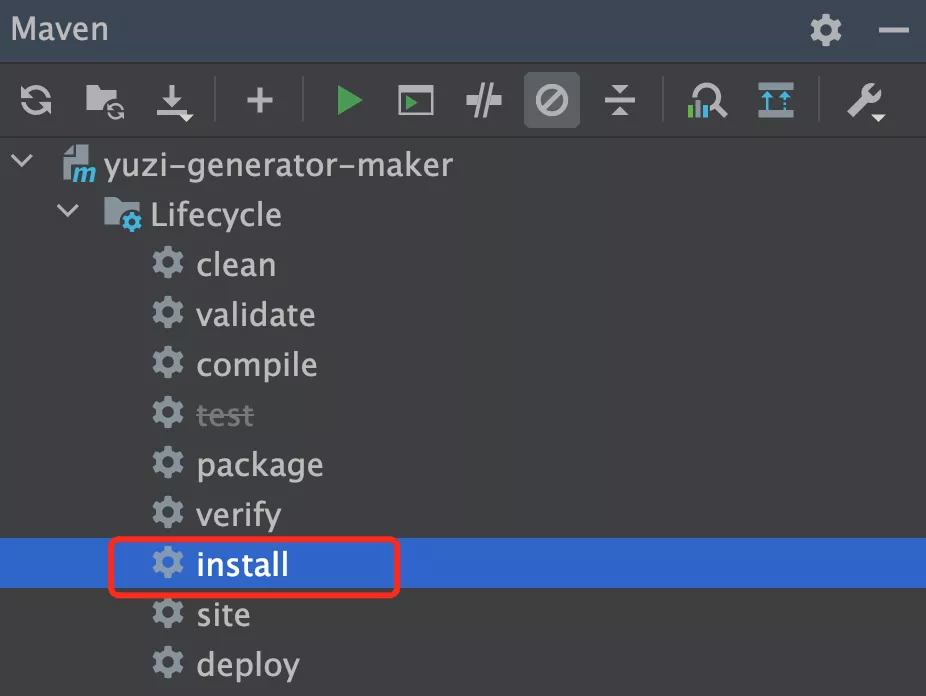
- 在 web 后端项目中引入 maker 项目依赖包
- 最好手动引入和 maker 项目一致的 freemarker 依赖版本,防止可能的冲突
- 将 web 项目中自己复制的 Meta 类删除,替换为 maker 包的 Meta 类
<!-- 引入 maker 项目 -->
<dependency>
<groupId>com.yupi</groupId>
<artifactId>yuzi-generator-maker</artifactId>
<version>1.0-SNAPSHOT</version>
</dependency>
<!-- https://freemarker.apache.org/index.html -->
<dependency>
<groupId>org.freemarker</groupId>
<artifactId>freemarker</artifactId>
<version>2.3.32</version>
</dependency>
全局替换包名即可
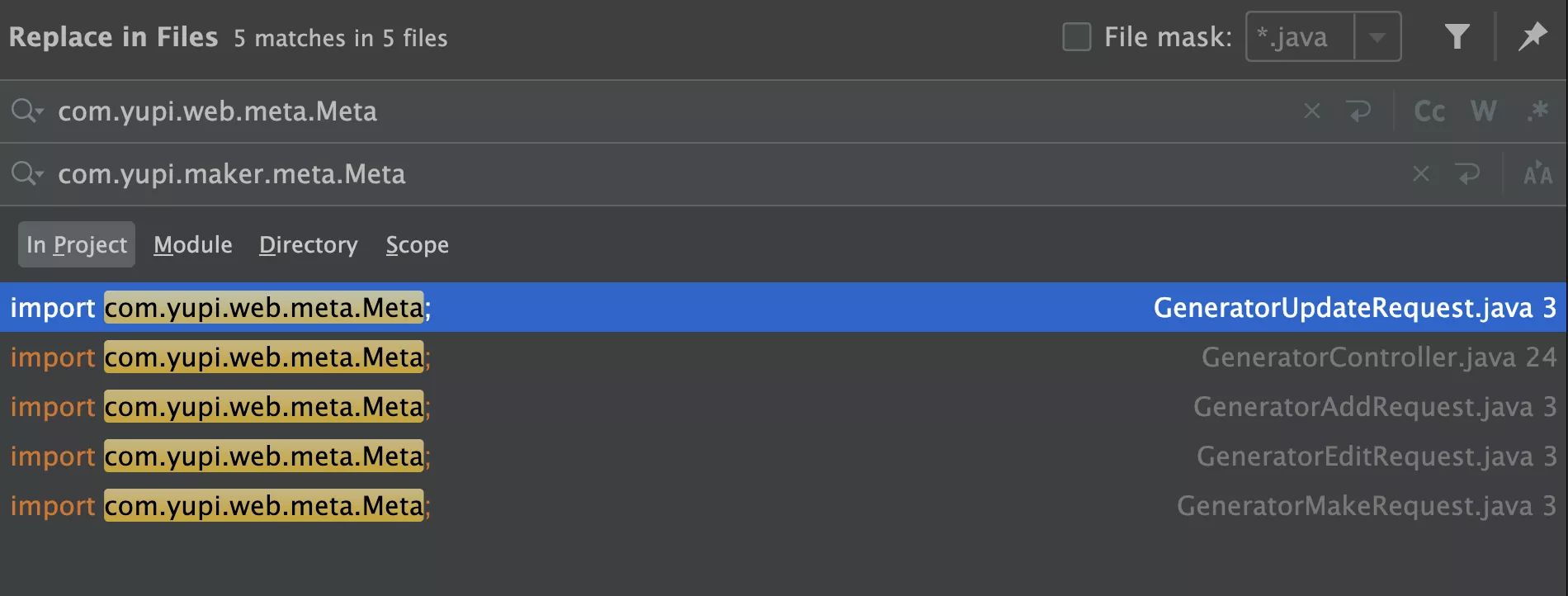
- 处理资源路径问题
- 非常重要! 在 maker 项目中,需要读取
resources目录下的 FTL 模板文件来生成代码,之前是通过路径拼接的方式获取的。但是,项目被制作为 jar 包被其他项目引入后,无法再通过文件路径获取模板文件 - 解决方案是:不再通过文件路径获取资源,而是通过类加载器,根据资源的相对路径获取
- 重写
DynamicFileGenerator的doGenerate(),改名为doGenerateByPath(),这样不用修改调用方代码
- 非常重要! 在 maker 项目中,需要读取
/**
* 使用相对路径生成文件
*
* @param relativeInputPath 相对输入路径
* @param outputPath 输出路径
* @param model 数据模型
* @throws IOException
* @throws TemplateException
*/
public static void doGenerate(String relativeInputPath, String outputPath, Object model) throws IOException, TemplateException {
// new 出 Configuration 对象,参数为 FreeMarker 版本号
Configuration configuration = new Configuration(Configuration.VERSION_2_3_32);
int lastSplitIndex = relativeInputPath.lastIndexOf("/");
String basePackagePath = relativeInputPath.substring(0, lastSplitIndex);
String templateName = relativeInputPath.substring(lastSplitIndex + 1);
// 指定模板文件所在的路径
ClassTemplateLoader templateLoader = new ClassTemplateLoader(DynamicFileGenerator.class, basePackagePath);
configuration.setTemplateLoader(templateLoader);
// 设置模板文件使用的字符集
configuration.setDefaultEncoding("utf-8");
// 创建模板对象,加载指定模板
Template template = configuration.getTemplate(templateName);
// 文件不存在则创建文件和父目录
if (!FileUtil.exist(outputPath)) {
FileUtil.touch(outputPath);
}
// 生成
Writer out = new FileWriter(outputPath);
template.process(model, out);
// 生成文件后别忘了关闭哦
out.close();
}
/**
* 生成文件
*
* @param inputPath 模板文件输入路径
* @param outputPath 输出路径
* @param model 数据模型
* @throws IOException
* @throws TemplateException
*/
@Deprecated
public static void doGenerateByPath(String inputPath, String outputPath, Object model) throws IOException, TemplateException {
// new 出 Configuration 对象,参数为 FreeMarker 版本号
Configuration configuration = new Configuration(Configuration.VERSION_2_3_32);
// 指定模板文件所在的路径
File templateDir = new File(inputPath).getParentFile();
configuration.setDirectoryForTemplateLoading(templateDir);
// 设置模板文件使用的字符集
configuration.setDefaultEncoding("utf-8");
// 创建模板对象,加载指定模板
String templateName = new File(inputPath).getName();
Template template = configuration.getTemplate(templateName);
// 文件不存在则创建文件和父目录
if (!FileUtil.exist(outputPath)) {
FileUtil.touch(outputPath);
}
// 生成
Writer out = new FileWriter(outputPath);
template.process(model, out);
// 生成文件后别忘了关闭哦
out.close();
}
修改 GenerateTemplate 的 generateCode(),只需修改输入资源路径变量即可,其他代码都不用改动!
软件开发的最小修改原则:在进行系统修改时,应该尽量只修改必要的部分,以最小化对现有系统的影响
protected void generateCode(Meta meta, String outputPath) throws IOException, TemplateException {
String inputResourcePath = "";
}
2. 在线制作接口
- 定义接口:接受用户输入的元信息配置和模板文件路径,返回代码生成器文件
- 为了便于处理,用户上传的模板文件 必须遵循一定的规范
- 必须为压缩包,有利于后端下载
- 必须直接把所有模板文件在根目录打包,而不能多套一层项目目录
- web 后端的
FileUploadBizEnum文件上传枚举要新增业务类别,用于存储用户上传的模板文件压缩包:
- 为了便于处理,用户上传的模板文件 必须遵循一定的规范
GENERATOR_MAKE_TEMPLATE("生成器制作模板文件", "generator_make_template");
- 创建工作空间,从对象存储下载模板文件压缩包
- 先判断模板文件是否存在
- 定义一个独立的工作空间,用来存放下载的模板文件、其他临时文件等
- 使用之前开发过的
cosManager.download对象存储文件下载方法,下载压缩包
- 解压文件,得到项目模板文件
- 构造制作工具所需的参数,包括 Meta 对象和生成器文件输出路径
- 构造 Meta 对象时,一定要指定 sourceRootPath 为我们刚刚下载并解压的模板文件,才能让制作工具进行处理。并且还要调用
MetaValidator.doValidAndFill给 meta 对象填充默认值,这个流程和之前我们在 maker 制作工具内执行是一致的 - 输出路径就放到工作空间下的
generated目录中
- 构造 Meta 对象时,一定要指定 sourceRootPath 为我们刚刚下载并解压的模板文件,才能让制作工具进行处理。并且还要调用
- 调用制作工具
- 返回制作好的代码生成器压缩包
- 制作工具已经生成了代码生成器的压缩包,直接下载即可
- 清理文件
- 已经将结果返回给前端了,最后可以异步清理无用文件,目前可以直接清理整个工作空间
/**
* 制作代码生成器
*
* @param generatorMakeRequest
* @param request
* @param response
*/
@PostMapping("/make")
public void makeGenerator(@RequestBody GeneratorMakeRequest generatorMakeRequest, HttpServletRequest request, HttpServletResponse response) throws IOException {
// 1)输入参数
String zipFilePath = generatorMakeRequest.getZipFilePath();
Meta meta = generatorMakeRequest.getMeta();
// 需要登录
User loginUser = userService.getLoginUser(request);
// 2)创建独立工作空间,下载压缩包到本地
if (StrUtil.isBlank(zipFilePath)) {
throw new BusinessException(ErrorCode.NOT_FOUND_ERROR, "压缩包不存在");
}
// 工作空间
String projectPath = System.getProperty("user.dir");
// 随机 id
String id = IdUtil.getSnowflakeNextId() + RandomUtil.randomString(6);
String tempDirPath = String.format("%s/.temp/make/%s", projectPath, id);
String localZipFilePath = tempDirPath + "/project.zip";
// 新建文件
if (!FileUtil.exist(localZipFilePath)) {
FileUtil.touch(localZipFilePath);
}
try {
cosManager.download(zipFilePath, localZipFilePath);
} catch (InterruptedException e) {
throw new BusinessException(ErrorCode.SYSTEM_ERROR, "压缩包下载失败");
}
// 3)解压,得到项目模板文件
File unzipDistDir = ZipUtil.unzip(localZipFilePath);
// 4)构造 meta 对象和输出路径
String sourceRootPath = unzipDistDir.getAbsolutePath();
meta.getFileConfig().setSourceRootPath(sourceRootPath);
MetaValidator.doValidAndFill(meta);
String outputPath = String.format("%s/generated/%s", tempDirPath, meta.getName());
// 5)调用 maker 方法制作生成器
GenerateTemplate generateTemplate = new ZipGenerator();
try {
generateTemplate.doGenerate(meta, outputPath);
} catch (Exception e) {
e.printStackTrace();
throw new BusinessException(ErrorCode.SYSTEM_ERROR, "制作失败");
}
// 6)下载压缩的产物包文件
String suffix = "-dist.zip";
String zipFileName = meta.getName() + suffix;
String distZipFilePath = outputPath + suffix;
// 下载文件
// 设置响应头
response.setContentType("application/octet-stream;charset=UTF-8");
response.setHeader("Content-Disposition", "attachment; filename=" + zipFileName);
// 写入响应
Files.copy(Paths.get(distZipFilePath), response.getOutputStream());
// 7)清理文件
CompletableFuture.runAsync(() -> {
FileUtil.del(tempDirPath);
});
}
3. 接口测试
- 首先要准备模板文件压缩包,可以直接压缩
yuzi-generator-demo-projects/acm-template-pro项目。注意要遵循规范,进入到目录中全选文件打包,不要把项目目录也打包进去了 - 利用已有的前端文件上传,将压缩包上传到对象存储,得到临时的文件路径(zipFilePath)
- Swagger 接口文档,复制 maker 项目中的
meta.json,作为请求参数的元信息来测试(移除fileConfig根层级的配置)
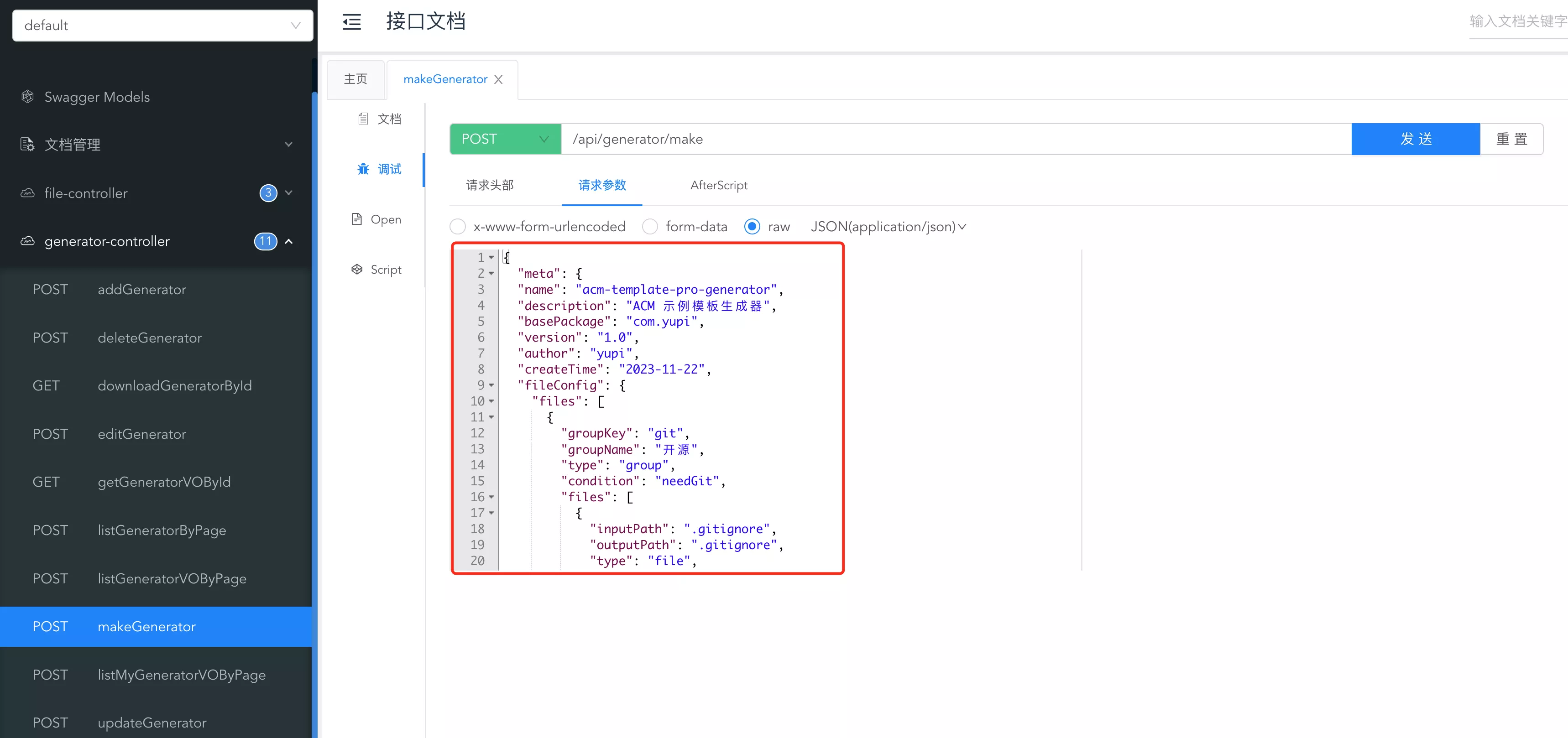
{
"meta": {
"name": "acm-template-pro-generator",
"description": "ACM 示例模板生成器",
"basePackage": "com.yupi",
"version": "1.0",
"author": "yupi",
"createTime": "2023-11-22",
"fileConfig": {
"type": "dir",
"files": [
{
"groupKey": "git",
"groupName": "开源",
"type": "group",
"condition": "needGit",
"files": [
{
"inputPath": ".gitignore",
"outputPath": ".gitignore",
"type": "file",
"generateType": "static"
},
{
"inputPath": "README.md",
"outputPath": "README.md",
"type": "file",
"generateType": "static"
}
]
},
{
"inputPath": "src/com/yupi/acm/MainTemplate.java.ftl",
"outputPath": "src/com/yupi/acm/MainTemplate.java",
"type": "file",
"generateType": "dynamic"
}
]
},
"modelConfig": {
"models": [
{
"fieldName": "needGit",
"type": "boolean",
"description": "是否生成 .gitignore 文件",
"defaultValue": true
},
{
"fieldName": "loop",
"type": "boolean",
"description": "是否生成循环",
"defaultValue": false,
"abbr": "l"
},
{
"groupKey": "mainTemplate",
"groupName": "核心模板",
"type": "MainTemplate",
"description": "用于生成核心模板文件",
"condition": "loop",
"models": [
{
"fieldName": "author",
"type": "String",
"description": "作者注释",
"defaultValue": "yupi",
"abbr": "a"
},
{
"fieldName": "outputText",
"type": "String",
"description": "输出信息",
"defaultValue": "sum = ",
"abbr": "o"
}
]
}
]
}
},
"zipFilePath": "generator_make_template/1867463332429049858/I1lxcfeV-Archive.zip"
}
4. 前端页面开发
1. 创建生成器的文件配置
1. 开发
- 参考模型配置表单组件,复制为
FileConfigForm组件,在此基础上进行开发
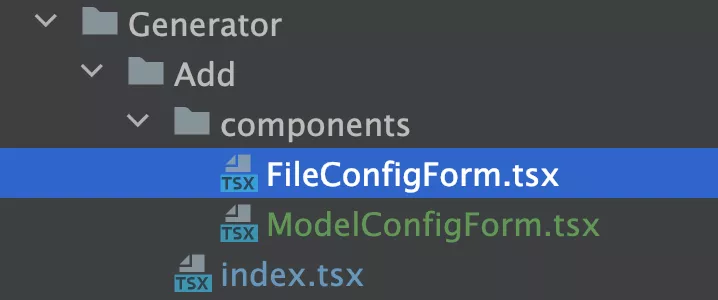
- 页面开发
- 全局替换部分变量。eg:
model替换为file、模型替换为文件 - 修改表单项,部分选项可枚举的表单项使用 Select 下拉选择组件
- 全局替换部分变量。eg:
<Form.Item label="类型" name={[field.name, 'type']}>
<Select
style={{
minWidth: 80,
}}
options={[
{ value: 'file', label: '文件' },
{ value: 'dir', label: '目录' },
]}
/>
</Form.Item>
<Form.Item label="生成类型" name={[field.name, 'generateType']}>
<Select
style={{
minWidth: 80,
}}
options={[
{ value: 'static', label: '静态' },
{ value: 'dynamic', label: '动态' },
]}
/>
</Form.Item>
需要注意,如果用户添加文件分组,要在默认值中补充分组信息(尤其是 type = group)
<Button
type="dashed"
onClick={() =>
add({
groupName: '分组',
groupKey: 'group',
type: 'group',
})
}
>
添加分组
</Button>
- 体验优化
- 在创建生成器的过程中,因为文件配置是否填写都不影响用户的使用、而且用户一般并不关注,所以文件配置的填写优先级不高。可以将它和模型配置更换位置
- 增加提示语 “如果不需要使用在线制作功能,可不填写”,降低用户创建生成器的成本
<StepsForm.StepForm name="modelConfig" title="模型配置">
<ModelConfigForm formRef={formRef} oldData={oldData} />
</StepsForm.StepForm>
<StepsForm.StepForm name="fileConfig" title="文件配置">
<FileConfigForm formRef={formRef} oldData={oldData} />
</StepsForm.StepForm>
<Alert message="如果不需要使用在线制作功能,可不填写" type="warning" closable />
- 测试创建和修改
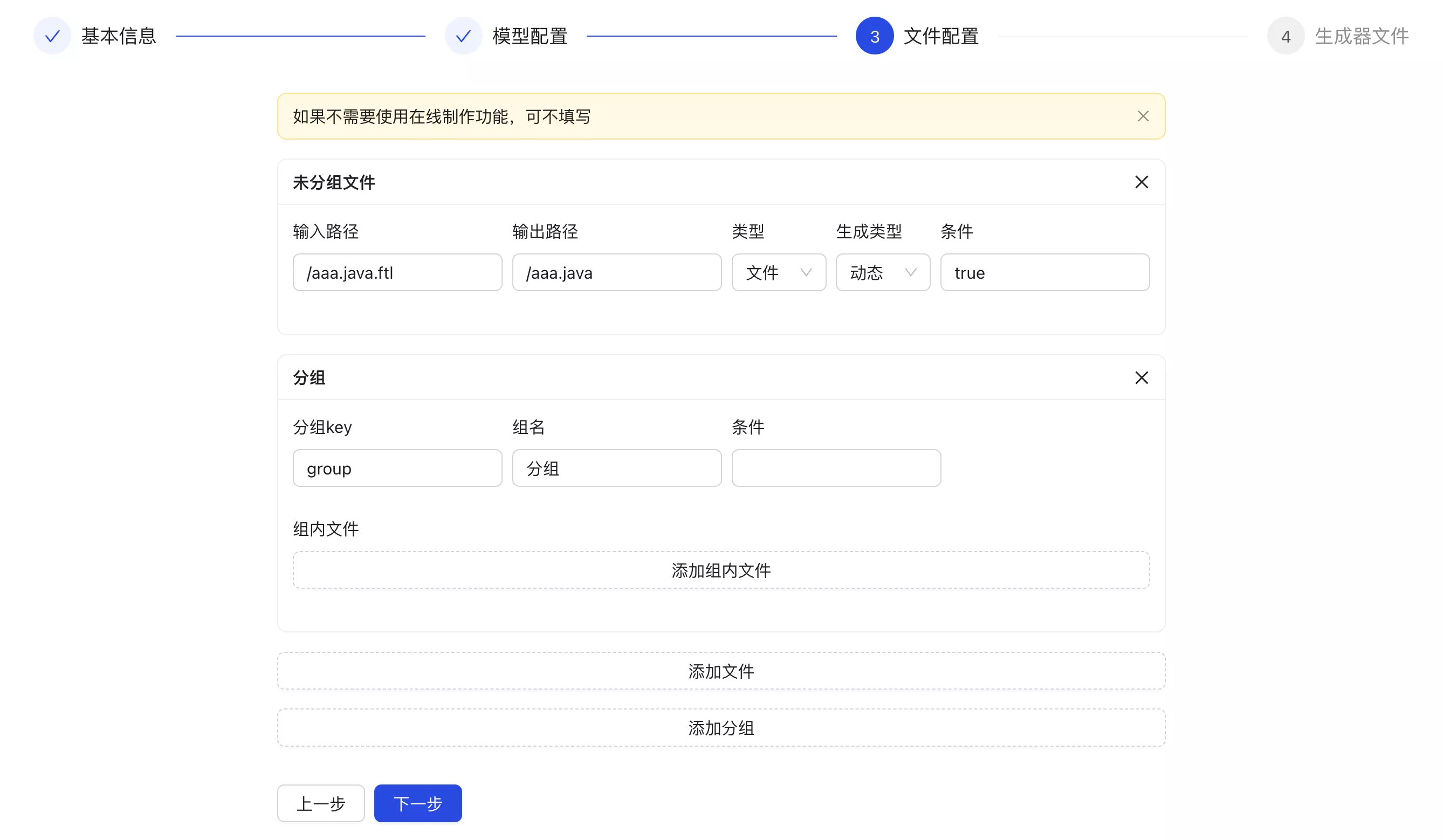
2. 完整代码
import { CloseOutlined } from '@ant-design/icons';
import { Alert, Button, Card, Form, FormListFieldData, Input, Select, Space } from 'antd';
interface Props {
formRef: any;
oldData: any;
}
export default (props: Props) => {
const { formRef, oldData } = props;
/**
* 单个文件表单视图
* @param field
* @param remove
*/
const singleFieldFormView = (
field: FormListFieldData,
remove?: (index: number | number[]) => void,
) => {
return (
<Space key={field.key}>
<Form.Item label="输入路径" name={[field.name, 'inputPath']}>
<Input />
</Form.Item>
<Form.Item label="输出路径" name={[field.name, 'outputPath']}>
<Input />
</Form.Item>
<Form.Item label="类型" name={[field.name, 'type']}>
<Select
style={{
minWidth: 80,
}}
options={[
{ value: 'file', label: '文件' },
{ value: 'dir', label: '目录' },
]}
/>
</Form.Item>
<Form.Item label="生成类型" name={[field.name, 'generateType']}>
<Select
style={{
minWidth: 80,
}}
options={[
{ value: 'static', label: '静态' },
{ value: 'dynamic', label: '动态' },
]}
/>
</Form.Item>
<Form.Item label="条件" name={[field.name, 'condition']}>
<Input />
</Form.Item>
{remove && (
<Button type="text" danger onClick={() => remove(field.name)}>
删除
</Button>
)}
</Space>
);
};
return (
<>
<Alert message="如果不需要使用在线制作功能,可不填写" type="warning" closable />
<div style={{ marginBottom: 16 }} />
<Form.List name={['fileConfig', 'files']}>
{(fields, { add, remove }) => {
return (
<div style={{ display: 'flex', rowGap: 16, flexDirection: 'column' }}>
{fields.map((field) => {
const fileConfig =
formRef?.current?.getFieldsValue()?.fileConfig ?? oldData?.fileConfig;
const groupKey = fileConfig.files?.[field.name]?.groupKey;
return (
<Card
size="small"
title={groupKey ? '分组' : '未分组文件'}
key={field.key}
extra={
<CloseOutlined
onClick={() => {
remove(field.name);
}}
/>
}
>
{groupKey ? (
<Space>
<Form.Item label="分组key" name={[field.name, 'groupKey']}>
<Input />
</Form.Item>
<Form.Item label="组名" name={[field.name, 'groupName']}>
<Input />
</Form.Item>
<Form.Item label="条件" name={[field.name, 'condition']}>
<Input />
</Form.Item>
</Space>
) : (
singleFieldFormView(field)
)}
{/* 组内文件 */}
{groupKey && (
<Form.Item label="组内文件">
<Form.List name={[field.name, 'files']}>
{(subFields, subOpt) => (
<div
style={{
display: 'flex',
flexDirection: 'column',
rowGap: 16,
}}
>
{subFields.map((subField) =>
singleFieldFormView(subField, subOpt.remove),
)}
<Button type="dashed" onClick={() => subOpt.add()} block>
添加组内文件
</Button>
</div>
)}
</Form.List>
</Form.Item>
)}
</Card>
);
})}
<Button type="dashed" onClick={() => add()}>
添加文件
</Button>
<Button
type="dashed"
onClick={() =>
add({
groupName: '分组',
groupKey: 'group',
type: 'group',
})
}
>
添加分组
</Button>
<div style={{ marginBottom: 16 }} />
</div>
);
}}
</Form.List>
</>
);
};
2. 制作生成器功能
1. 开发
- 新建
GeneratorMaker组件- 接受用户已填写的 meta 信息,作为属性
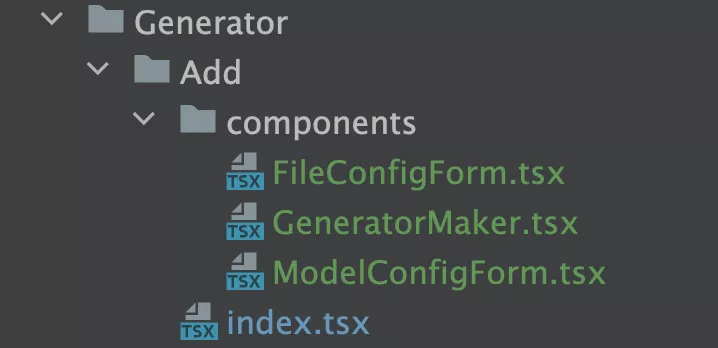
- 创建页面引入该组件
- 由于 Ant Design 的分步表单组件中,通过
formRef.current.getFieldsValue得到的表单值始终只有当前步骤的,不包括之前已填写的,无法直接传递给生成器制作组件 - 需要定义三个状态变量,记录表单数据。每一个分步表单中,增加
onFinish函数,用户点击 “下一步” 时,会更新内容到状态变量中 - 将生成器制作组件放到上传生成器文件的表单底部,并传递状态变量
- 由于 Ant Design 的分步表单组件中,通过
- 组件开发
- 结构比较简单,主要是一个文件上传表单,并且在外层使用折叠组件,可以控制表单的展开和收纳
- 编写提交表单的函数,和之前的文件上传逻辑类似,提交表单时需要校验、并将 file 对象转为 url 路径
- 测试
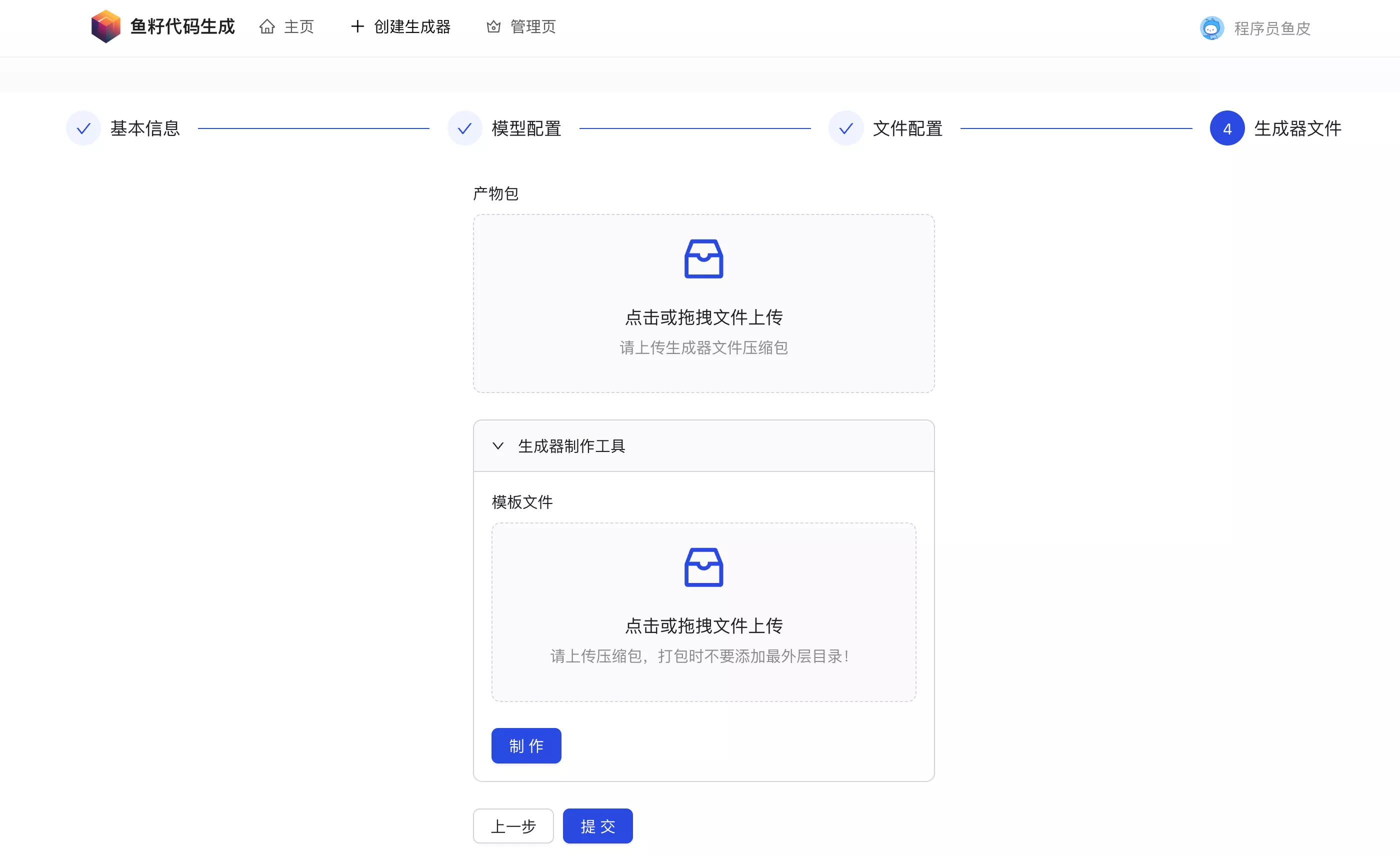
import FileUploader from '@/components/FileUploader';
import { makeGeneratorUsingPost } from '@/services/backend/generatorController';
import { ProForm, ProFormItem } from '@ant-design/pro-form';
import { Collapse, Form, message } from 'antd';
import { saveAs } from 'file-saver';
interface Props {
meta: API.GeneratorAddRequest | API.GeneratorEditRequest;
}
/**
* 生成器制作
* @param props
*/
export default (props: Props) => {
const { meta } = props;
const [form] = Form.useForm();
/**
* 提交
* @param values
*/
const doSubmit = async (values: API.GeneratorMakeRequest) => {
// 校验
if (!meta.name) {
message.error('请填写名称');
return;
}
const zipFilePath = values.zipFilePath;
if (!zipFilePath || zipFilePath.length < 1) {
message.error('请上传模板文件压缩包');
return;
}
// 文件列表转 url
// @ts-ignore
values.zipFilePath = zipFilePath[0].response;
try {
const blob = await makeGeneratorUsingPost(
{
meta,
zipFilePath: values.zipFilePath,
},
{
responseType: 'blob',
},
);
// 使用 file-saver 来保存文件
saveAs(blob, meta.name + '.zip');
} catch (error: any) {
message.error('下载失败,' + error.message);
}
};
/**
* 表单视图
*/
const formView = (
<ProForm
form={form}
submitter={{
searchConfig: {
submitText: '制作',
},
resetButtonProps: {
hidden: true,
},
}}
onFinish={doSubmit}
>
<ProFormItem label="模板文件" name="zipFilePath">
<FileUploader
biz="generator_make_template"
description="请上传压缩包,打包时不要添加最外层目录!"
/>
</ProFormItem>
</ProForm>
);
return (
<Collapse
style={{
marginBottom: 24,
}}
items={[
{
key: 'maker',
label: '生成器制作工具',
children: formView,
},
]}
/>
);
};
5. 扩展思路
- 填写文件配置信息是个比较麻烦的操作,能否支持先上传模板文件,然后自动生成文件配置信息?或者支持上传文件夹,自动识别出文件列表?
- 支持传入
meta.json元信息配置文件来创建生成器。用户如果使用本地模板制作工具得到了现成的元信息文件,就能够在制作完成后直接创建、自动填充表单、再二次修改,不用完全从 0 开始在前端填写 - 给代码生成器增加更多状态。eg:制作中、打包中、待发布、审核中、已发布,设置一套完备的状态流转逻辑
- 补充前后端的异常处理逻辑。eg:后端响应异常时,前端仍然能下载文件